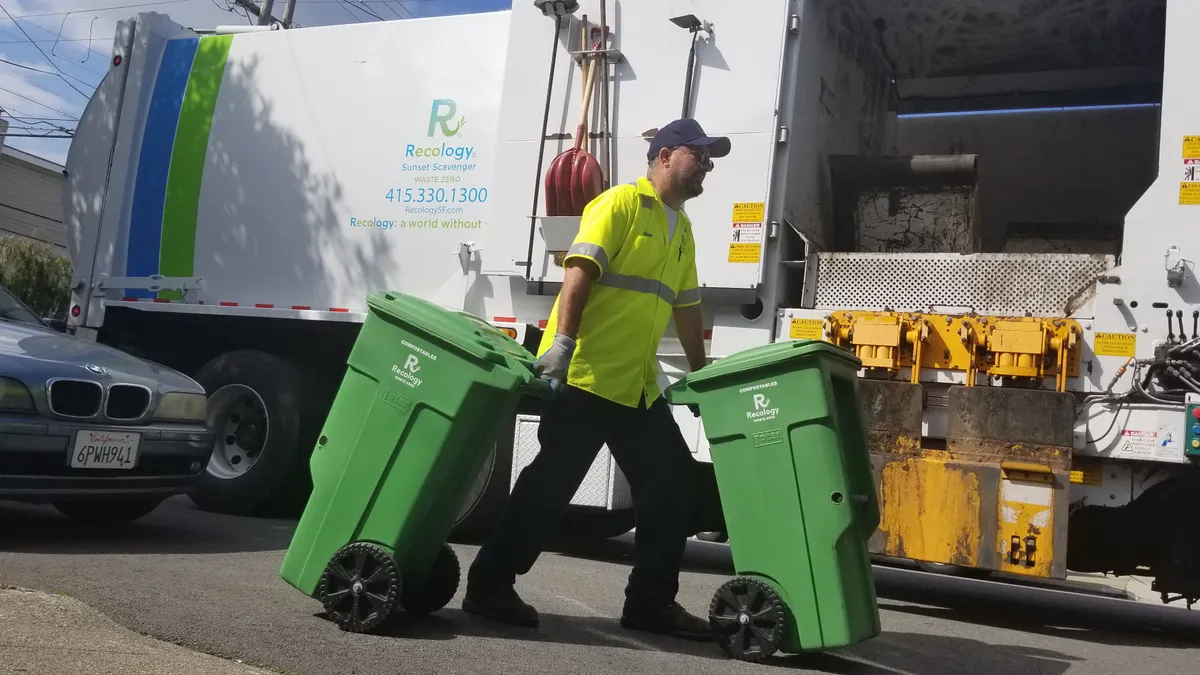Dive Brief:
- Real-world testing shows that certified food-contact compostable packaging successfully breaks down at commercial composting facilities that meet reasonable operating conditions for elements like moisture and temperature, according to a report released Tuesday by the Composting Consortium. An 18-month study tested more than 23,000 packaging units at 10 different commercial composting facilities.
- Compostable plastic packaging broke down 98% by surface area when composted, and compostable fiber packaging broke down 83% by surface area. In both cases, that exceeds the minimum threshold for disintegration established by compost industry groups: 90% and 80%, respectively.
- The report notes that collaboration across the composting value chain and infrastructure investment are necessary to ensure widespread acceptance of new compostable packaging materials. “[U]nlocking the full potential of certified food-contact compostable packaging demands a multi-faceted approach,” the report said.
Dive Insight:
The Composting Consortium, which is managed by the Center for the Circular Economy at Closed Loop Partners, calls this study the largest known North American field test of certified compostable packaging. It launched this project to fill data gaps on compostable packaging’s performance in real-world conditions and improve understanding of the composting conditions that support disintegration. The report provides insights as well as recommendations for composters, consumer goods companies and packaging manufacturers.
The study began in late 2022 and examined 31 types of fiber and compostable plastic packaging and products. The 10 participating commercial composting facilities span the U.S., with more in the eastern half of the country. The report concluded that the “findings offer strong evidence for the efficacy of compostable packaging as a sustainable alternative to conventional plastics.”
Researchers found that compostable plastic successfully broke down regardless of processing time or method: windrow, aerated static pile or in-vessel technologies. The report describes an ongoing debate about whether compostable plastics that are not completely bio-based should be included as a compost feedstock. Authors said the report was not intended to “pass” or “fail” certain materials, but rather to illustrate their disintegration levels in real-world conditions. They reported that compostable plastics “seemed to successfully disintegrate in every composting technology process tested.”
On the fiber side, mechanical turning or agitation helps with disintegration in compost piles, the study found. And facilities with weekly moisture levels consistently above 50% experienced better fiber disintegration.
Generally, “composters do not consider fiber packaging a contaminant when fragments remain in their finished product because fiber packaging is not included as a contaminant in compost quality requirements,” the report stated. Therefore, composters typically are more accepting of fiber packaging and its performance is held to different standards than compostable plastics.
All the compostable products studied exhibited notably higher levels of disintegration under the “dose method” than the “mesh bag method,” suggesting that the mesh bag method produces conservative results and/or the dose method overestimates results. The latter method involves containing compostable packaging in a mesh bag during processing, whereas the dose method involves directly mixing the packaging into fresh feedstock.
The report recommends that brands advocate for measuring disintegration by surface area as opposed to weight because that method is considered a more reliable measure than weight, which “is more susceptible to sources of error and systematically underestimates disintegration results in field testing.”
For example, fiber or compostable plastic packaging can absorb oils, which adds weight. “This added weight caused nearly a third of our weight measurements to result in readings over 100%, despite disintegration having taken place,” according to the report.
Proper design for compostable packaging is also critical, including clear labeling of both compostable and non-compostable products to avoid contamination in compost streams. Poor design can lead to incomplete disintegration, which affects compost quality and can prompt some composters to accept only food scraps but not compostable packaging.
Some composters do not accept packaging due to the risk of lookalikes entering the stream. Of the composters that do not accept compostable packaging, 78% cite the main reason as confusion between conventional plastic packaging and compostable versions. Composting Consortium data shows that 85% of composters’ contamination stems from conventional rigid and flexible plastics.
“Brands, retailers and packaging manufacturers have a responsibility to formulate these packaging and products in a manner that aligns with the diverse technologies and methods employed by composters,” the report said.
The consortium plans to share the data gathered for this report to the Compostable Field Testing Program, an international nonprofit research group that aims to “bring field testing to composters across North America and beyond.” The Composting Consortium also said the data will support development of the first ASTM field-test standard for compostable packaging.
















